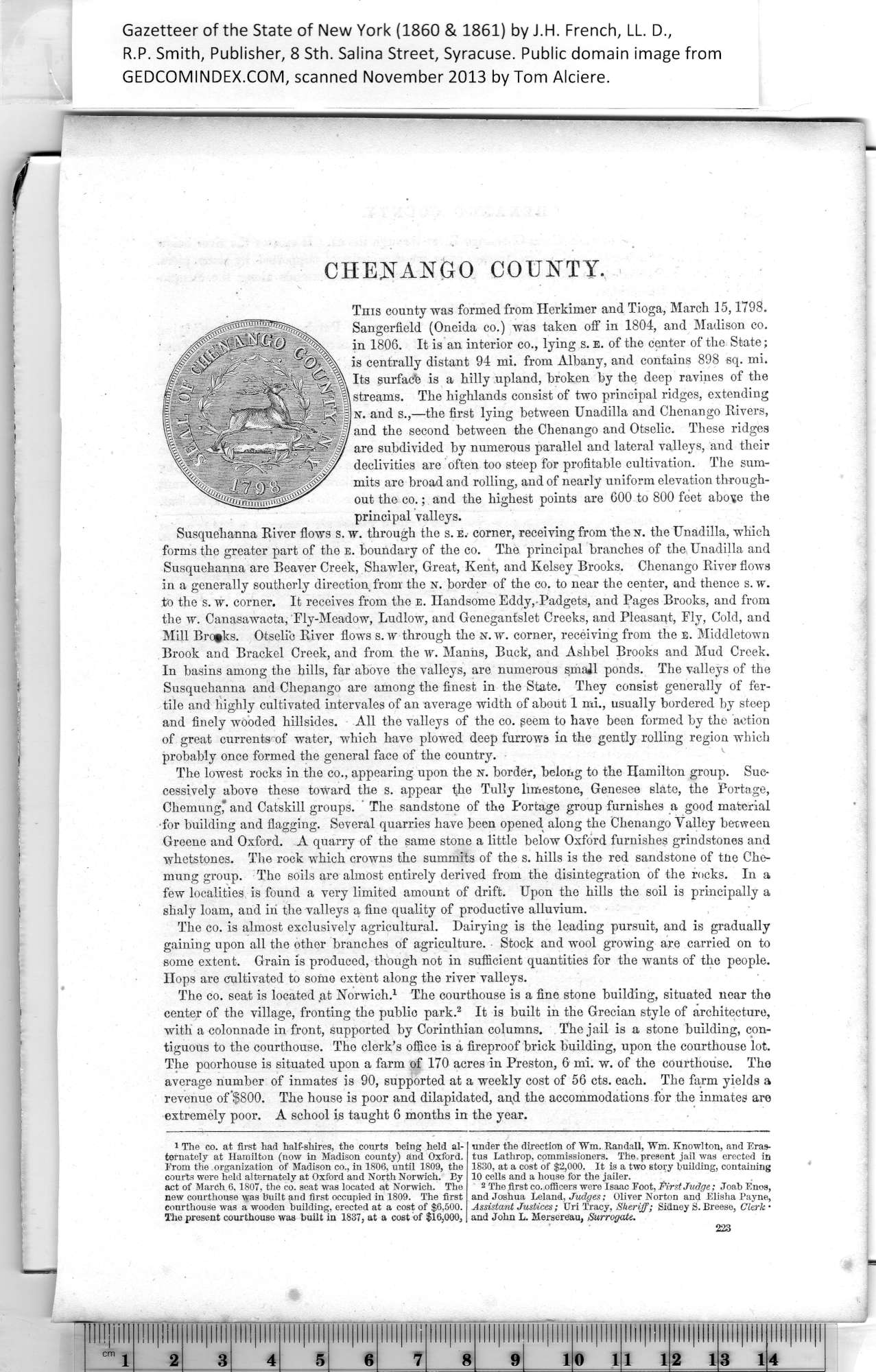|
CHENANGO COUNTY.
This county was formed from Herkimer and Tioga, March 15,1798.
Sangerfield (Oneida co.) was taken off in 1804, and Madison co.
in 1806. It is an interior co., lying s. e. of the center of the State;
is centrally distant 94 mi. from Albany, and contains 898 sq. mi.
Its snrfac'e is a hilly upland, broken by the deep ravines of the
streams. The highlands consist of two principal ridges, extending
N. and s.,—the first lying between Unadilla and Chenango Rivers,
and the second between the Chenango and Otselic. These ridges
are subdivided by numerous parallel and lateral valleys, and their
declivities are often too steep for profitable cultivation. The sum¬
mits are broad and rolling, and of nearly uniform elevation through¬
out the co.; and the highest points are 600 to 800 feet abo\e the
principal valleys.
Susquehanna River flows s. w. through the s. e.- corner, receiving from the n. the Unadilla, which
forms the greater part of the e. boundary of the co. The principal branches of the Unadilla and
Susquehanna are Beaver Creek, Shawler, Great, Kent, and Kelsey Brooks. Chenango River flows
in a generally southerly direction from the n. border of the co. to near the center, and thence s. w.
to the s. w. corner. It receives from the e. Handsome Eddy, Padgets, and Pages Brooks, and from
the w. Canasawacta, Fly-Meadow, Ludlow, and Genegantslet Creeks, and Pleasant, Fly, Cold, and
Mill Bro*ks. Otselic River flows s. w through the N. w. corner, receiving from the e. Middletown
Brook and Brackel Creek, and from the w. Manns, Buck, and Ashbel Brooks and Mud Creek.
In basins among the hills, far above the valleys, are numerous smail ponds. The valleys of the
Susquehanna and Chenango are among the finest in the State. They consist generally of fer¬
tile and highly cultivated intervales of an average width of about 1 mi., usually bordered by steep
and finely wooded hillsides. All the valleys of the co. seem to have been formed by the action
of great currents of water, which have plowed deep furrows in the gently rolling region which
probably once formed the general face of the country.
The lowest rocks in the co., appearing upon the n. border, belong to the Hamilton group. Suc¬
cessively above these toward the s. appear the Tully limestone, Genesee slate, the Portage,
Chemung* and Catskill groups. The sandstone of the Portage group furnishes a good material
for building and flagging. Several quarries have been opened along the Chenango Yalley between
Greene and Oxford. A quarry of the same stone a little below Oxford furnishes grindstones and
whetstones. The rock which crowns the summits of the s. hills is the red sandstone of tne Che¬
mung group. The soils are almost entirely derived from the disintegration of the rocks. In a
few localities is found a very limited amount of drift. Upon the hills the soil is principally a
shaly loam, and in the valleys a fine quality of productive alluvium.
The co. is almost exclusively agricultural. Dairying is the leading pursuit, and is gradually
gaining upon all the other branches of agriculture. Stock and wool growing are carried on to
some extent. Grain is produced, though not in sufficient quantities for the wants of the people.
Hops are cultivated to some extent along the river valleys.
The co. seat is located at Norwich.1 The courthouse is a fine stone building, situated near the
center of the village, fronting the public park.2 It is built in the Grecian style of architecture,
with a colonnade in front, supported by Corinthian columns. The jail is a stone building, con¬
tiguous to the courthouse. The clerk’s office is a fireproof brick building, upon the courthouse lot.
The poorhouse is situated upon a farm of 170 acres in Preston, 6 mi. w. of the courthouse. The
average number of inmates is 90, supported at a weekly cost of 56 cts. each. The farm yields a
revenue of $800. The house is poor and dilapidated, and the accommodations for the inmates are
extremely poor. A school is taught 6 months in the year.
|
under the direction of Wm. Randall, Wm. Knowlton, and Eras-
tus Lathrop, commissioners. The.present jail was erected in
1830, at a cost of $2,000. It is a two story building, containing
10 cells and a house for the jailer.
2 The first co. officers were Isaac Foot, First Judge; Joab Enos,
and Joshua Leland, Judges; Oliver Norton and Elisha Payne,
Assistant Justices; Uri Tracy, Sheriff; Sidney S. Breese, Clerk •
and John L. Mersereau, Surrogate. |
223
1
The co. at first had half-shires, the courts being held al¬
ternately at Hamilton (now in Madison county) and Oxford.
From the organization of Madison co., in 1806, until 1809, the
courts were held alternately at Oxford and North Norwich. By
act of March 6, 1807, the co. seat was located at Norwich. The
new courthouse was built and first occupied in 1809. The first
courthouse was a wooden building, erected at a cost of $6,500.
The present courthouse was built in 1837, at a cost of $16,000,
|
